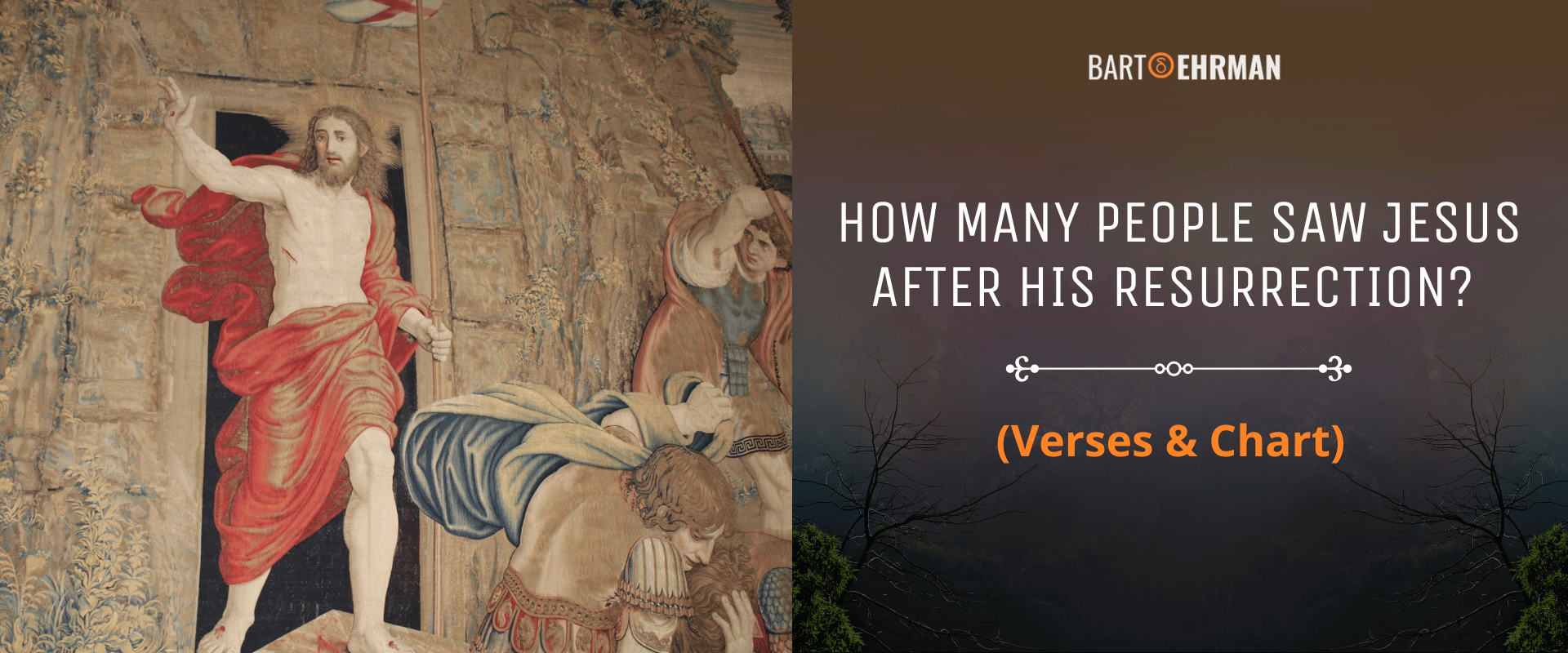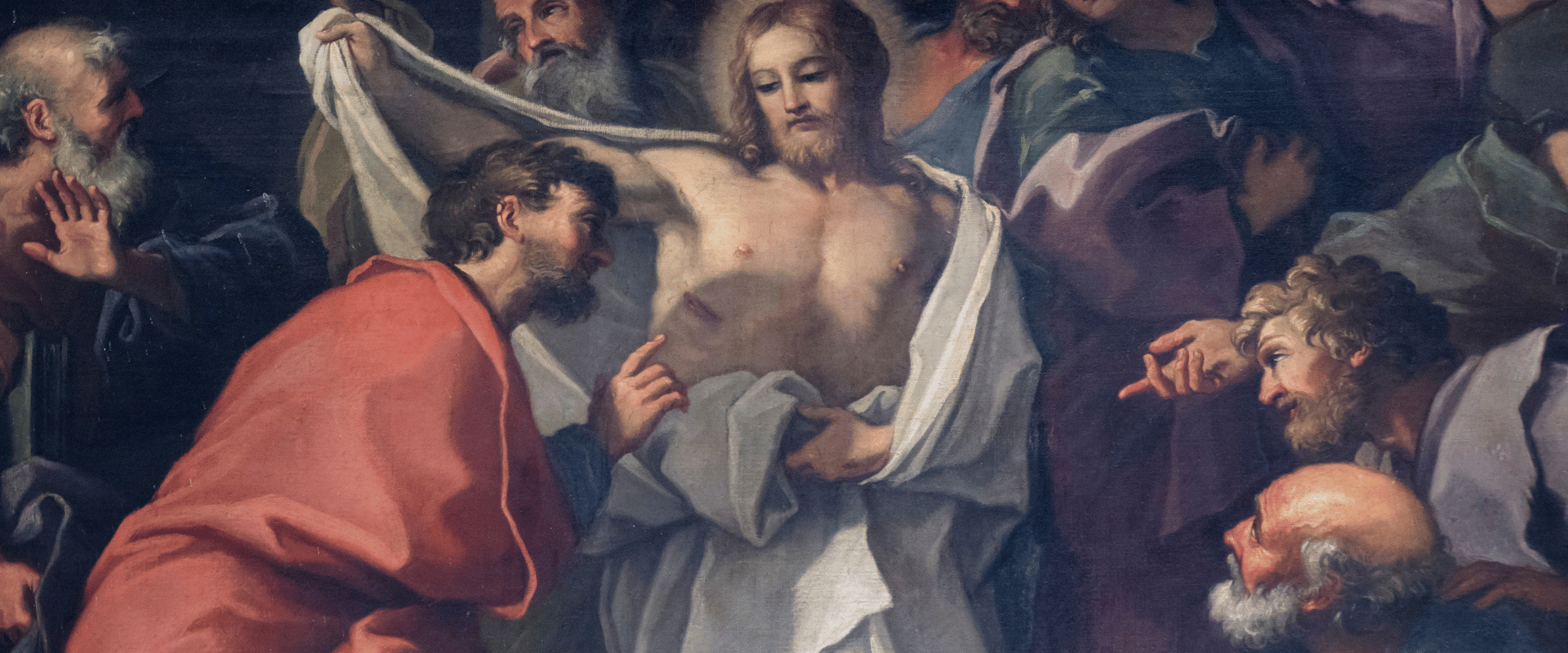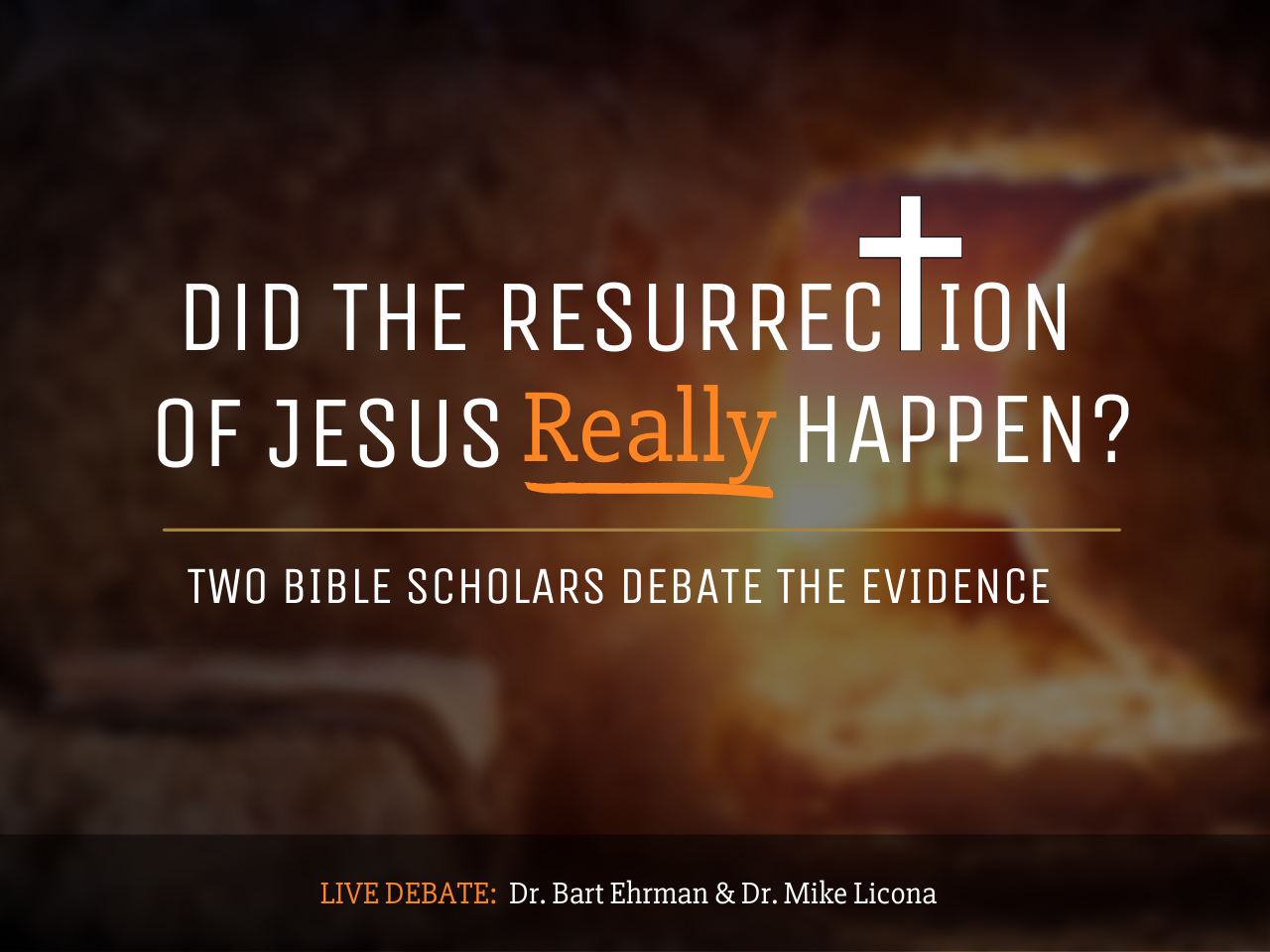How Many People Saw Jesus After His Resurrection? (Verses & Chart)

Written by Marko Marina, Ph.D.
Author | Historian | BE Contributor
Verified! See our guidelines
Verified! See our editorial guidelines
Date written: August 5th, 2024
Disclaimer: The views and opinions expressed in this article belong to the author and do not necessarily match my own. - Dr. Bart D. Ehrman
Arguably, the most controversial claim of Christianity is that Jesus was raised from the dead — a claim central to the Christian religion. As Paul emphatically states, “If Christ has not been raised, your faith is futile” (1 Cor 15:19). The resurrection isn’t just a theological concept; it's a historical assertion that, if proven false, would undermine the entire foundation of Christianity.
If Jesus had been crucified and no one proclaimed his resurrection, Christianity likely wouldn't exist today. Instead, Jesus would be remembered as another Jewish prophet who suffered for his teachings, with his followers fading into the vast landscape of ancient history.
The question of how many people saw Jesus after his resurrection is, therefore, a fascinating historical inquiry. Our previous article delves deeply into the historical evidence for and against Jesus' resurrection, evaluating sources, testimonies, and scholarly interpretations.
This article builds on that foundation. It provides a detailed presentation of the post-resurrection appearances as recorded in the ancient sources.
In the following sections, we’ll explore the stories of those who saw Jesus resurrected — from the women at the tomb to the disciples on the road to Emmaus and his appearance to over 500 people. We’ll start with the earliest source, Paul’s letters, and move through the Gospel accounts.
Additionally, we’ll analyze these appearances from a scholarly perspective, discussing what historians can deduce from them and how they approach such extraordinary claims. Stay tuned as we journey through the historical records and explore one of the most crucial questions in Christian history.

Appearances as Revealed in Jesus Resurrection Bible Verses
Paul’s Letter to the Corinthians
Our earliest account of Jesus' post-resurrection appearances comes from Paul's letter to the Corinthians. It's one of his undisputed letters, written in 55 or 56 C.E. to a community in the Greek city of Corinth. In 1 Corinthians 15:3-8, Paul provides a list of those who allegedly witnessed the risen Jesus.
He writes:
For what I received I passed on to you as of first importance: that Christ died for our sins according to the Scriptures, that he was buried, that he was raised on the third day according to the Scriptures, and that he appeared to Cephas, and then to the Twelve. After that, he appeared to more than five hundred of the brothers and sisters at the same time, most of whom are still living, though some have fallen asleep. Then he appeared to James, then to all the apostles, and last of all he appeared to me also, as to one abnormally born.
Paul's account is almost certainly part of the pre-Pauline tradition. In his Commentary, Joseph Fitzmyer notes that "Paul’s argument is kerygmatic, i.e. based on the common preaching of the early church. (Affiliate Disclaimer: We may earn commissions on products you purchase through this page at no additional cost to you. Thank you for supporting our site!) He recalls to the Corinthian Christians the salvific value of the gospel that has already been preached to them, by himself as the founder of the church in that city, but also by other evangelists whom he has mentioned earlier.”
This passage is foundational for understanding how many people saw Jesus after his resurrection according to early Christian tradition. Paul’s testimony includes not just individual appearances, such as to Peter (Cephas) and James, but also collective experiences, notably Jesus’ appearance to over five hundred people at once.
By highlighting these post-resurrection appearances, Paul reinforces the core message of the Christian gospel and its proclamation. His emphasis on the number and variety of witnesses aims to bolster the credibility and communal validation of Jesus’ resurrection.
The Gospel of Matthew
Another important alleged post-resurrection appearance derives from the Gospel of Matthew, written by an anonymous Christian in the later part of the 1st century. Matthew provides two significant post-resurrection accounts.
The first one (Mt 28:1-10) describes Jesus appearing to Mary Magdalene and the other Mary after his resurrection. According to this passage, the two women visit Jesus' tomb and encounter an angel who informs them that Jesus has risen.
As they leave the tomb to convey this message to the disciples, Jesus meets and greets them. This encounter affirms the women's role as the first witnesses of the resurrection and Jesus’ true identity as the resurrected Messiah.
In their Commentary on Matthew, William D. Davies and Dale C. Allison rightly point out: “Without the resurrection Jesus' words are vacant and his opponents exonerated. With it, Jesus is vindicated, his cause and authority confirmed, and his opponents disgraced.”
The second account, known as the Great Commission, occurs in Matthew 28:16-20. In this passage, Jesus appears to the eleven disciples on a mountain in Galilee. He commissions them to go forth and make disciples of all nations, baptizing them and teaching them to observe all he has commanded.
These two accounts in Matthew emphasize the immediate and profound effect of Jesus' appearance after his resurrection.
The first account highlights the personal and intimate nature of the encounters with Jesus, beginning with the women who remained faithful to him. The second one broadens the scope and describes the universal mission entrusted to the disciples.
The Gospel of Luke
The author of Luke's Gospel, writing approximately at the same time as Matthew, offers more insight into Jesus' post-resurrection appearances, providing two compelling narratives that depict interactions with followers after his death.
Did You Know?
One of the most intriguing resurrection stories comes from the Gospel of Peter, a text discovered in 1886. This apocryphal gospel provides a vivid and detailed account of Jesus' resurrection. According to the narrative, while guards watch the tomb at night, they witness the heavens splitting open and two angelic beings descending.
As these celestial figures approach, the stone sealing the tomb rolls away by itself. The angels enter the tomb and soon emerge, supporting Jesus between them. But the spectacle doesn't end there. Following the angels and Jesus out of the tomb is a cross, which remarkably speaks. A voice from heaven asks, “Have you preached to those who are asleep?” to which the cross replies, “Yes.”
The first narrative (Lk 24:13-35) describes the encounter on the road to Emmaus. Two of Jesus' disciples are walking to the village of Emmaus, discussing the events surrounding his crucifixion and reports of his resurrection.
Jesus joins them on their journey, but they don’t recognize him. As they walk, he explains the Scriptures concerning himself. Later, as they share a meal, their eyes are opened, and they realize who he is.
Joel B. Green, in his Commentary on Luke, notes: “The Emmaus account is structured in such a way as to call particular attention to the progression from lack of recognition to full recognition and to the means by which insight is gained, and thus to underscore the women's earlier affirmation that Jesus is alive.”
The second narrative, detailed in Luke 24:36-49, describes Jesus' appearance to his disciples in Jerusalem. Unlike Matthew, who places the appearance in Galilee, Luke is adamant that it occurred in Jerusalem — one among several points of contradiction.
Jesus suddenly appears among his disciples, startling and frightening them, as they initially think they are seeing a ghost. He reassures them by showing his hands and feet and eating a piece of broiled fish. Jesus then opens their minds to understand the Scriptures and commissions them to preach repentance and forgiveness of sins in his name to all nations, starting from Jerusalem.
These two accounts in Luke’s Gospel contribute significantly to the question of how many people saw Jesus after his resurrection. The Emmaus narrative and the appearance in Jerusalem emphasize bodily aspects of Jesus' resurrection. He eats with the disciples, they touch his hands and feet to make sure he isn’t a ghost.
For Luke, therefore, Jesus’ post-resurrection appearances serve to establish the empty tomb and his bodily resurrection.
The Gospel of John
The Gospel of John probably comes from the 90s of the 1st century. Its author is an anonymous Christian living outside of Palestine, likely in Ephesus. The basic story of Jesus in John parallels that of the Synoptic Gospels, running from the ministry of John the Baptist to the death and resurrection of Jesus.
However, even the stories that also appear in the Synoptic Gospels look remarkably different in John. Furthermore, John contains unique stories not found in the Synoptic Gospels. We can see these differences and additions by looking at John's description of Jesus' post-resurrection appearances.
The first account, in John 20:11-18, describes Jesus appearing to Mary Magdalene. Mary is weeping outside the tomb when she sees two angels seated where Jesus' body had been. Turning around, she sees Jesus but does not recognize him until he calls her by name.
The second account, found in John 20:19-29, involves Jesus appearing to his disciples. Initially, he appears to the disciples in a locked room, offering them peace and showing them his wounds. Thomas, one of the disciples, is absent and later expresses doubt about Jesus' resurrection, earning the nickname “doubting Thomas.”
A week later, Jesus appears again, specifically addressing Thomas' doubts by inviting him to touch his wounds. Finally convinced, Thomas utters the famous “My Lord and My God” (John 20:28) statement. Referring to this passage, Craig C. Keener concludes: “In this case, as in the
prologue, the confession of Jesus’ deity is unmistakable. It cannot simply represent an acclamation to the Father, since John explicitly claims that the words are addressed to Jesus.”
The third account (John 21:1-14) describes Jesus appearing to his disciples by the Sea of Galilee. The disciples are fishing but have caught nothing. At dawn, Jesus appears on the shore, though the disciples don’t initially recognize him. He instructs them to cast their net on the right side of the boat, resulting in a miraculous catch of fish.
These post-resurrection appearances in the New Testament Gospels add depth to the question of how many people saw Jesus after his resurrection. Each account provides unique details and emphasizes different aspects of interactions with his followers.
And how many days did Jesus stay on Earth after the resurrection? If we were to believe the account in the Acts, he stayed with the disciples 40 days before his final ascension to heaven (1:1-3).

How Many People Saw Jesus After His Resurrection?
Think keeping track of your social engagements is hard? Imagine trying to catalog all the people who allegedly saw Jesus after his resurrection! Here’s a handy table to make sense of it all:
Verse | Witnesses |
|---|---|
1 Corinthians 15:3-8 | Cephas (Peter), the Twelve, 500 brothers and sisters, James, all the apostles, and Paul |
Matthew 28:1-10 | Mary Magdalene and the other Mary |
Matthew 28:16-20 | The eleven Disciples |
Luke 24:13-35 | Two Disciples |
Luke 24:36-49 | The Disciples |
John 20:11-18 | Mary Magdalene |
John 20:19-23 | All Disciples except Thomas |
John 20:24-29 | The Disciples, including "doubting Thomas" |
John 21:1-14 | The Disciples |
Having explored how many people saw Jesus after the resurrection, we’ll now take a scholarly look at these post-resurrection appearances.
Jesus’ Post-Resurrection Appearances: A Scholarly Approach
Throughout Christian history, believers have often appealed to physical proof of the miraculous aspects of Jesus' life and afterlife. These are known as relics, tangible embodiments of power associated with Jesus’ passion.
For example, in the Middle Ages, it was widely believed that the cup Jesus used at the Last Supper, the Holy Grail, conferred powers of immortality. While none of these relics hold historical credibility, they reveal the desire among some Christians to experience Jesus’ presence after his earthly life ended.
Similarly, the stories of Jesus' resurrection and his appearances emphasize the perceived reality of his continuing presence. These narratives assert that Jesus not only survived the grave but physically rose from the dead and will never die again.
However, the question of whether Jesus was raised from the dead can never be answered purely on historical grounds, and this impossibility extends to post-resurrection appearances. If Jesus was indeed resurrected, it would have been a miraculous act of God.
As Bart D. Ehrman notes in his highly acclaimed book The New Testament: A Historical Introduction, any miracle claim is, by definition, beyond the scope of what historical evidence can demonstrate.
Regarding our earliest source, Paul probably had a religious vision he interpreted as an encounter with the resurrected Jesus. Some visions are considered veridical, meaning visual experiences of phenomena that are actually present. Christians would claim that Paul’s vision of Jesus was veridical, thus asserting he truly appeared to Paul.
Non-veridical visions, on the other hand, can be induced by a chemical imbalance, fatigue, grief, or other factors. Non-Christians might argue that Paul’s visions were hallucinations rather than genuine encounters.
What can historians tell us about Paul's claims? The most prudent approach is to acknowledge that several of Jesus' followers likely had visions of him after his crucifixion. But what about the 500 witnesses mentioned by Paul? There is no corroborating evidence for this event.
As Dale C. Allison notes in The Resurrection of Jesus:
Regarding the appearance to more than five hundred in 1 Cor. 15:6, our knowledge is near nil... Despite all the exegetical ink, 1 Cor. 15:6 remains an enigma. It is little more than a tease, a tantalizing hint about something that, barring the discovery of a new source, will forever provoke questions without answers, or at least answers without robust support… Yet we really know nothing about this ostensibly stupendous event. We have only a brief assertion, from someone who was not there, that it happened, and we cannot name a single individual who was involved.
It’s plausible that some of Jesus' followers, such as Peter, Paul, and Mary, did have visions and shared their extraordinary experiences with others, who then believed and passed on these stories. This could have created a snowball effect, with more people claiming to have seen Jesus alive after his death.
Based on these stories, Matthew, Luke, and John developed their accounts, tailored to their theological perspectives and the social contexts of the communities for which they were writing.
But what did Peter, Paul, and Mary see? It’s impossible to determine. Without a new source from the middle of the 1st century (wouldn't that be great to have?!), the answer will depend largely on the worldview of the person asking the question.
While this might not be the definitive answer you hoped for, it’s the best historians can offer given the available evidence. And remember, when it comes to ancient history, sometimes the most definitive answer is, “We really don't know.” But isn't it fascinating to wonder?
Conclusion
In examining the accounts of Jesus' post-resurrection appearances, we find different, yet intriguing narratives, each contributing to the historical inquiry into how many people saw Jesus after his resurrection.
Paul's letters provide the earliest testimonies, emphasizing a diverse group of witnesses including individuals and large groups. The Gospels of Matthew, Luke, and John add further layers, each with unique details and perspectives that reflect their theological aims and the contexts of their communities.
However, while these accounts are foundational to Christian belief, their historical reliability remains a complex issue. Historians must navigate between the lines of faith and evidence, recognizing that miraculous claims, by nature, exceed the limits of historical verification.
For a deeper dive into the arguments for and against the historicity of Jesus' resurrection, be sure to check out our earlier article that thoroughly evaluates the evidence from both perspectives.
This continued exploration enriches our understanding and invites readers to engage thoughtfully with one of Christianity's most pivotal claims.
Interested in exploring more? Watch the recorded online debate “Did the Resurrection of Jesus Really Happen” between Bart D. Ehrman and Mike Licona. Discover different opinions and arguments. Decide for yourself.

